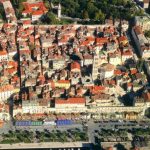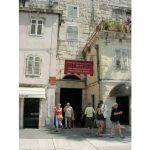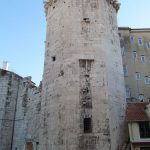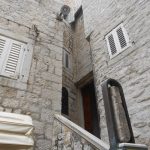The cellars of Diocletian’s Palace are housed within the southern half of the palace. The floor plan showcases a mirror image of the emperor’s residence above as this substructure acted as supporting walls. The basement halls was the entranceway into the palace by sea via the Brass Gate and previously, when the sea reached the very walls of the palace, boats would be able to berth in front of the gate to drop off supplies or receive noble guests. As you pass through the basement towards the north you will reach the stairs that lead you directly up the Peristil Square.
During the time of the emperor, the basement was largely used for storage of foodstuff and wine. Actually, the remnant of a large press, which was used to turn the grapes into wine, is still visible today showcasing that Diocletian surely enjoyed a glass or two of his own Dalmatian wines down here.
As you meander through the underground, find the circular room and notice the impeccable acoustics; above, this room was the foyer to the emperor’s bedrooms and Diocletian would be warned if anyone was coming at night due to the echoes left by anyone passing through. Emperor Diocletian was very paranoid about being killed and had specifically requested this feature; apparently with success as he is the only Roman emperor to have died of natural causes.
After the fall of the Roman Empire and the consequent settlement of various civilizations, the basement was used for various purposes. In the Middle Ages it was inhabited, and eventually it turned into a water storage facility but through time, the basement got clogged up completely. As additional houses were built above the basement, they drilled holes into their floors in order to use the basement is a sewage tank and garbage dump.
Croatian architect and the country’s first conservator, Vicko Andrić who constructed the Riva harbor-front devoted his retirement to the conservation of Diocletian’s Palace and began an excavation of the cellars in the 1850’s. Andrić drained and cleaned the cellars and archeological discoveries are still being made to this day, particularly in the far corners of the basement. Amongst other finds, older remains from the previous civilization of Aspalatos were also found.
Today, the cellars are open to the public although the eastern part was only opened up in May 1995 after the celebration of the patron saint of Split, Sv. Dujan (St. Domnium). The main hall of the basement houses tacky souvenir stalls where tourists can buy a reminder of their stay in Split. The other areas of the basement reveal a labyrinthine room layout, ideal for an archeological discovery. The basement is also a popular venue for various events such as art exhibitions, weddings, and the International Flower Show held in May.










